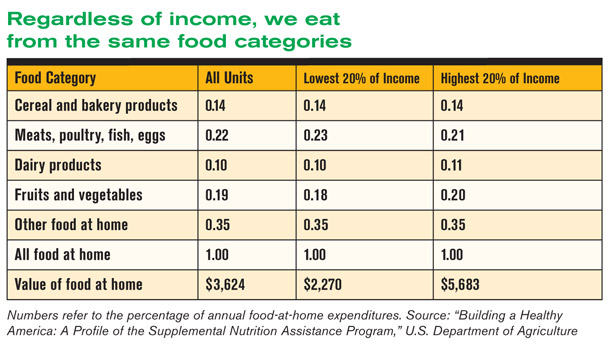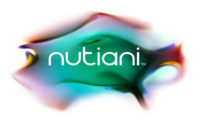Poor households spend most of their food stamp money (nearly 75%) on vegetables, fruits, grain products, meat, and meat alternatives, according to a study released in April. Lower-cost red meats (7.8%) and milk and yogurt (7.6%) account for the largest shares of food consumed at home. That’s the finding of a report titled “Building a Healthy America: A Profile of the Supplemental Nutrition Assistance Program” and published by the Food and Nutrition Service, Office of Research and Analysis, in the United States Department of Agriculture.
SNAP (the Supplemental Nutrition Assistance Program, formerly known as food stamps) is “the foundation of America’s national nutrition safety net” and one that “offers a powerful tool to improve nutrition among low-income people,” the authors write. In fiscal year 2011, SNAP served nearly 45 million people, or about one in seven Americans.
The rich, poor and middle class pretty much eat the same foods. USDA found little difference in the food choices of low-income and higher-income families. But higher-income families spent more than twice as much on food at home as those at the low end of the income scale.
All Americans, whether or not they receive food assistance, fall short of the recommendations in the Dietary Guidelines for Americans. In fact, the report says Americans’ diets fall “far” short. The overall average score on the Healthy Eating Index-20053 was 58 out of a possible 100. SNAP participants scored slightly lower (52). Those eligible for assistance but not taking it scored 56, as did higher-income nonparticipants. All groups had very low intakes of whole grains, dark green and orange vegetables, and legumes. All groups had high intakes of saturated fat. Too many discretionary calories came from solid fats, alcoholic beverages and added sugars, the report states.
SNAP participants are somewhat less likely to consume fruits or vegetables than other Americans, and the report’s authors found more differences among adults than among children. Most SNAP participants have adequate intakes for most vitamins, minerals, and macronutrients, except for Vitamin C, Vitamin A, magnesium and Vitamin E. But even higher-income individuals fail to consume adequate levels of magnesium and Vitamin E.
The majority of food assistance benefits are used in supermarkets and super stores, accounting for nearly two-thirds of all transactions and more than 80% of all redemptions. But aid recipients do not spend their benefits in only one store. Households shop at an average of four different stores. SNAP participants shop frequently; they use their benefits to make 10 purchases a month. The average transaction is about $30




